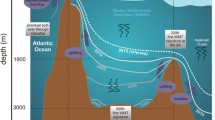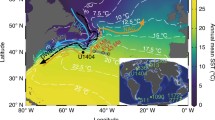Abstract
LITTLE is known of the interdecadal variability in the thermohaline circulation of the world's oceans, yet such knowledge is essential as a background to studies of the effects of natural and anthropogenic climate change. The subpolar North Atlantic is an area of extensive water mass modification by heat loss to the atmosphere. Lying as it does at the northern limit of the global thermohaline "conveyor belt"12, changes in this region may ultimately have global consequences. Here we report that in August 1991 the waters between Greenland and the United Kingdom were on average 0.08 °C and 0.15 °C colder than in 1962 and 1981, respectively, and slightly less saline than in 1962. The cause appears to be renewed formation of intermediate water in the Labrador Sea from cooler and fresher source waters, and the spreading of this water mass from the west. Variations in the source characteristics of Labrador Sea Water can be traced across the North Atlantic, with a circulation time of 18–19 years between the Labrador Sea and Rockall Trough. More recently formed Labrador Sea Water, with even lower temperature and salinity, should cool and freshen the North Atlantic still further as it circulates around the ocean in the coming decade.
Similar content being viewed by others
References
Gould, W. J. Cruise Report No. 230 (Institute of Oceanographic Sciences Deacon Laboratory,1992).
Clarke, R. A. & Gascard, J. C. J. phys. Oceanogr. 13, 1764–1778 (1983).
Talley, L. D. & McCartney, M. S. J. phys. Oceanogr. 12, 1189–1205 (1982).
Wallace, D. W. R. & Lazier, J. R. N. Nature 332, 61–63 (1988).
Lazier, J. R. N. & Gershey, R. M. WOCE News 11, 5–7 (1991).
Brewer, P. G. et al. Science 222, 1237–1239 (1983).
Swift, J. H. in Climate Processes and Climate Sensitivity (eds Hansen, J. E. & Takahasi, T.) 39–47 (AGU, Washington DC, 1984).
Swift, J. H. in Glaciers, Ice-Sheets, and Sea-Level Effect of a C02-induced Climate Change (ed. Lingle, C. S.) 129–138 (Department of Energy, Washington DC, 1985).
Lazier, J. R. N. Atmos. Ocean 18, 227–238 (1980).
Levitus, S. J. geophys. Res. 94, 6091–6131 (1989).
Levitus, S. J. geophys. Res. 94, 16125–16131 (1989).
Broecker, W. S., Peteet, D. M. & Rind, D. Nature 315, 21–26 (1985).
Stouffer, R. J., Manabe, S. & Bryan, K. Nature 342, 660–662 (1989).
Manabe, S., Bryan, K. & Stouffer, R. J. J. phys. Oceanogr. 20, 722–749 (1990).
Mikolajewicz, U., Santer, B. D. & Maier-Reimer, E. Nature 345, 589–593 (1990).
Author information
Authors and Affiliations
Rights and permissions
About this article
Cite this article
Read, J., Gould, W. Cooling and freshening of the subpolar North Atlantic Ocean since the 1960s. Nature 360, 55–57 (1992). https://doi.org/10.1038/360055a0
Received:
Accepted:
Issue Date:
DOI: https://doi.org/10.1038/360055a0
- Springer Nature Limited
This article is cited by
-
Hydrological cycle amplification reshapes warming-driven oxygen loss in the Atlantic Ocean
Nature Climate Change (2024)
-
Decadal prediction skill in the GEOS-5 forecast system
Climate Dynamics (2014)
-
Large-scale freshening of intermediate waters in the Pacific and Indian oceans
Nature (1999)
-
Decadal variability in the outflow from the Nordic seas to the deep Atlantic Ocean
Nature (1998)
-
The quasi—decadal oscillation of air—sea system in the northwestern Pacific region
Advances in Atmospheric Sciences (1998)





